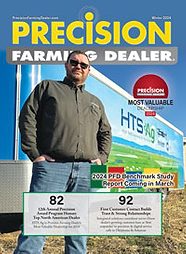Unmanned aerial vehicles or flying drones could take the legwork out of agronomy by identifying crop diseases and observe plant health in fields, say scientists.
February 14, 2013 — Engineers at Harper Adams University have teamed up with Chinese researchers to develop a fleet of ground-based robots and unmanned aerial vehicles that benefit farmers.
Jobs undertaken by robots could include locating and rounding up livestock in remote areas, precision application of fertiliser and the integration of controlled traffic farming.
 |
Simon Blackmore, head of engineering at Harper Adams, said unmanned aerial vehicles or drones fitted with cameras could also be used by agronomists instead of crop walking.
The government-backed project has seen Harper Adams University awarded £36,000 to further collaboration between the two countries.
The partnership will link the research with the Engineering Departments of Harper Adams and China Agricultural University, focusing on developments in precision agriculture.
Both universities are researching precision farming technologies.
The project aims to develop the protocols and controls required to operate a mixed fleet of robot agricultural vehicles capable of a diverse range of farming tasks.
A special exchange programme will see three members of staff and three PhD students from Harper Adams visit China during the next two years, while their counterparts visit the UK.
In a separate move, next month's Precision Farming Event at the East of England Showground will see the launch of a commercial company offering drone technology to farmers.
Unmanned aerial vehicles are already being successfully used to detect blackgrass in arable crops, said Mark Jarman, of Ursula Agriculture.
The vehicles fly at about 1,000 ft and can cover 150-250ha in a 30-minute flight - much faster than an crop-walking agronomist.


![[Technology Corner] Pessl Instruments CEO Talks Dealer Benefits From Lindsay Corp. Investment](https://www.precisionfarmingdealer.com/ext/resources/2024/04/25/Pessl-Instruments-CEO-Talks-Dealer-Benefits-From-Lindsay-Corp.-Investment.png?height=290&t=1714073368&width=400)



Post a comment
Report Abusive Comment